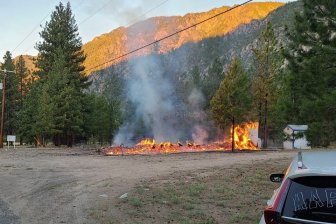The discovery of unmarked graves at residential schools in British Columbia and Saskatchewan has led to calls for thorough investigations into other sites across the country.
A team of geophysicists from Queen’s University is hoping to help in that search.
“So about two weeks ago, we had the idea of offering a GPR survey, training and review interpretation from a pool of experts,” says geophysics Professor Alexander Braun.
Ground-penetrating radar (GPR) was used to assist in the discovery of the residential school children in Kamloops and Cowessess First Nation.
While GPR technology is not 100 per cent accurate or complete, Braun says it can help advance these delicate searches in a non-invasive way.
“It’s one of the established geophysical surveying techniques. Often used for the shallowest subsurface, so let’s say the top 10-20 meters,” he says. “We know for burial sites we don’t have to look much deeper than two to three meters. And that allows us to get the best antenna and the best frequency.”
He says that it was able to work well for the previous unmarked grave sites because people already knew that the burial sites existed.
“In this case, I think, there was a lot of pre-existing knowledge about ‘there is a burial site here’ and the question was more, ‘where are the burials located?’ So there wasn’t much modelling required,” Braun says. “I would say they were pragmatic. They knew that there was something in the subsurface, let’s just take a survey, using state of the art equipment and look at the results.”
The Queen’s University professor is now offering his expertise, alongside a team of geophysicists, to help search for the remains of Indigenous children lost to the residential school system.
“We’re inviting every Indigenous community who is interested in using our services, again pro bono, to come forward. And we’re scheduling based on where our volunteers are in Canada and where our equipment is available, we’re scheduling a survey for them.”
While both the Ontario and Alberta governments have pledged funding towards identifying, investigating and commemorating residential school burial sites, Braun says their initiative won’t be receiving any funding.
“We are not going to fundraise, and we are not going to apply for any government funding. Including the $10 million from Ontario or the $8 million from Alberta. This should all go into Indigenous communities and not flow back into our hands or anybody else’s who is not part of an Indigenous community,” says Braun.
Dr. Braun says he has received a tremendous response from the geophysics community across the country and has now heard from other experts volunteering to assist however they can.
One Indigenous community, which Braun isn’t naming for privacy reasons, has already accepted the team’s offer. Surveying will begin as soon as the equipment is available and ready.
“The utmost care should be taken before you conduct the survey,” says Braun. “It should be done properly, and it should be done behind the scenes until we have enough confidence to say ‘this is what the situation is at this site.’”
Braun is inviting every Indigenous community interested in his group’s services, which are free, to reach out to him at [email protected].
Anyone experiencing pain or distress as a result of their residential school experience can access the 24-hour, toll-free and confidential National Indian Residential School Crisis Line at 1-866-925-4419.
© 2021 Global News, a division of Corus Entertainment Inc.








More Stories
Fair share: the right office solution can take finding the right partner
Ontario faces crew shortages, aircraft issues in fight against wildfires | Globalnews.ca
Refugee attends open house at Downtown Eastside affordable housing facility – BC | Globalnews.ca